Comprehensive Analysis of Business Operations and Team Development
VerifiedAdded on 2020/11/12
|13
|3256
|116
Report
AI Summary
This report provides a comprehensive overview of business operations, encompassing various key aspects. It begins by exploring the business environment and then delves into essential business functions, with a particular focus on the significance of accounting for business success. The report also examines the different functions carried out by the HR department, including training and development, employee relations, recruitment, and compensation benefits, as well as key features of employment legislation. Furthermore, the report includes an accounting workshop that interprets the information on a profit and loss account, providing insights into profitability. The report then transitions into a detailed analysis of teamwork, including an examination of Belbin's team role theory, stages of team development, and an assessment of three motivation theories and leadership styles. The report concludes with a brief overview of customer service. The report provides valuable insights into how businesses operate and manage their various functions, emphasizing the importance of accounting, HR, and effective teamwork for achieving organizational goals.
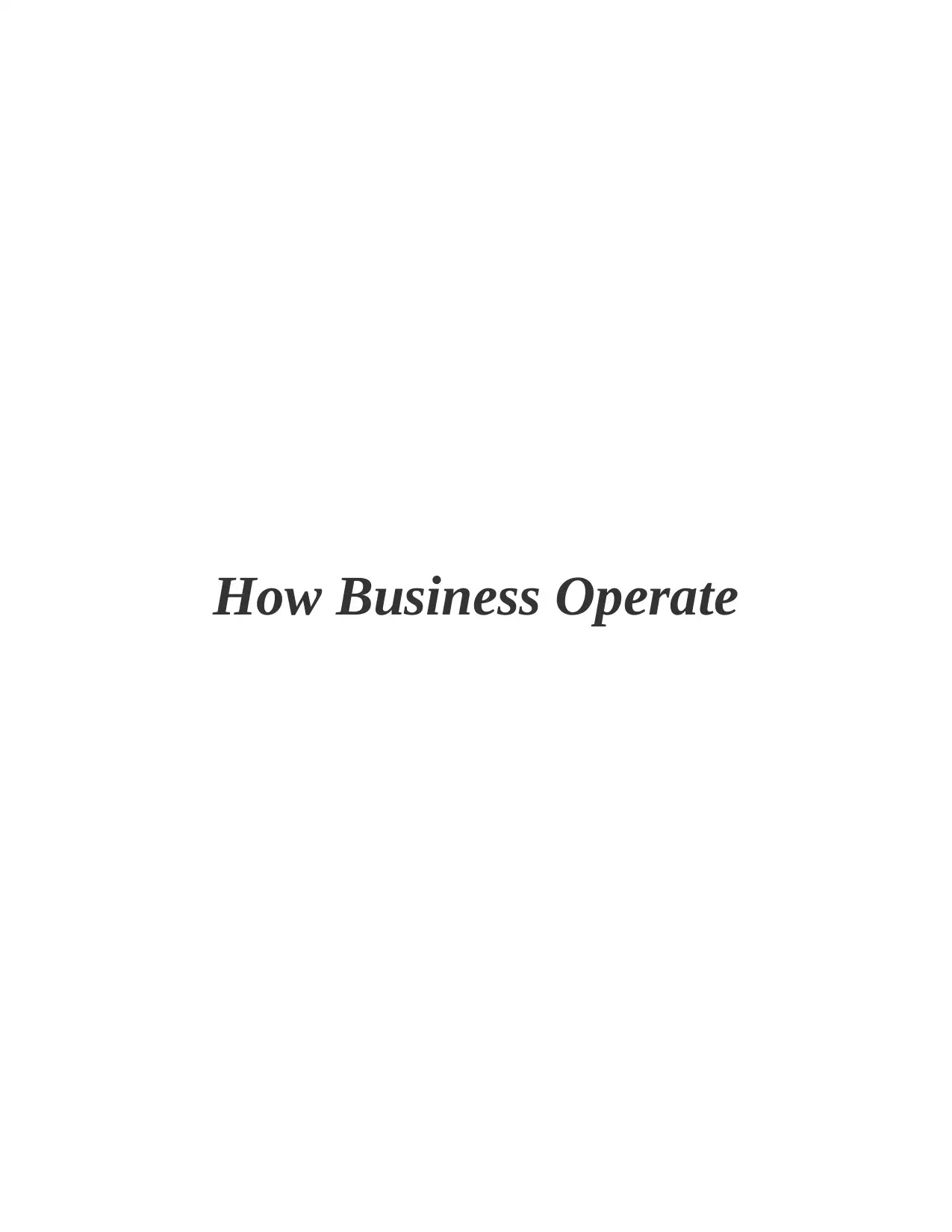
How Business Operate
Paraphrase This Document
Need a fresh take? Get an instant paraphrase of this document with our AI Paraphraser
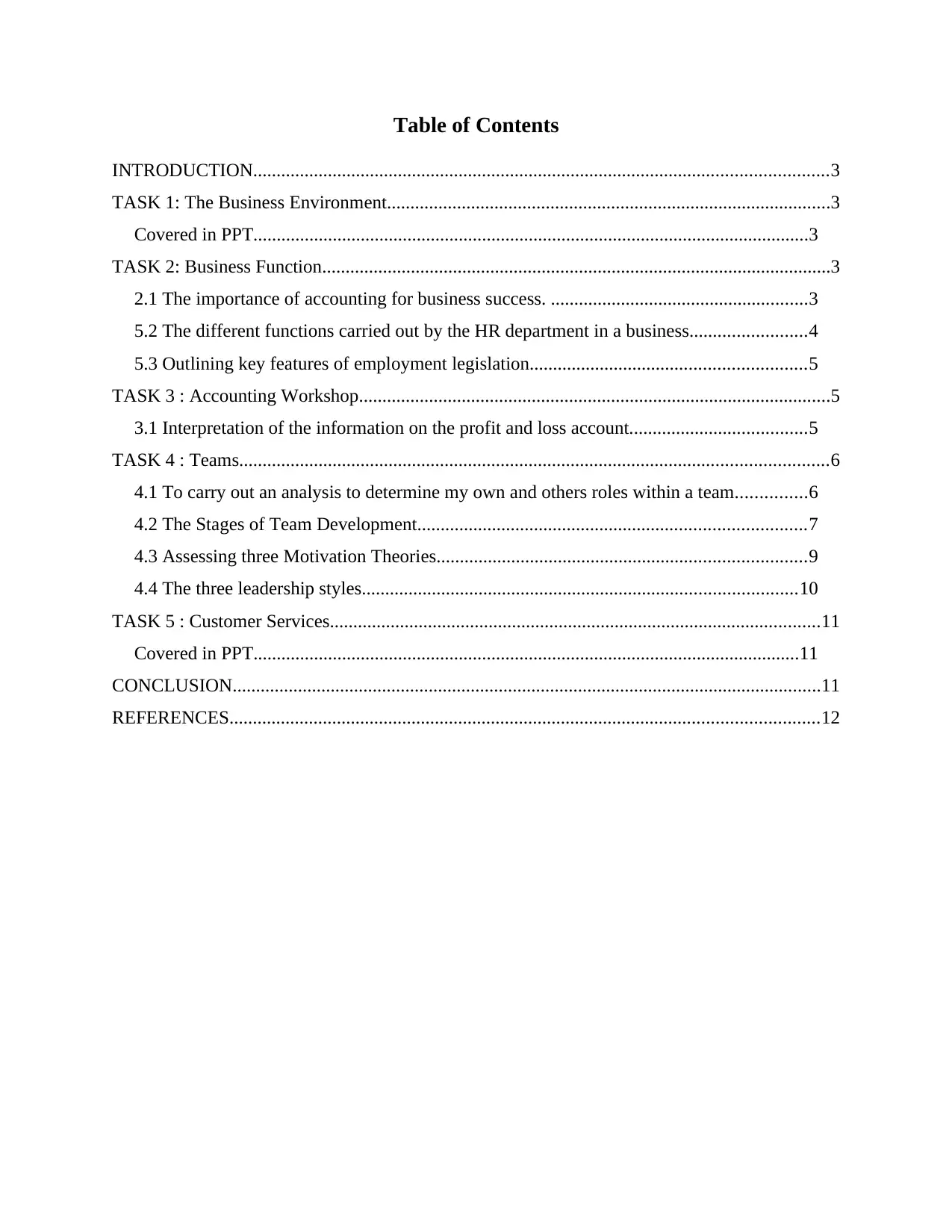
Table of Contents
INTRODUCTION...........................................................................................................................3
TASK 1: The Business Environment...............................................................................................3
Covered in PPT.......................................................................................................................3
TASK 2: Business Function.............................................................................................................3
2.1 The importance of accounting for business success. .......................................................3
5.2 The different functions carried out by the HR department in a business.........................4
5.3 Outlining key features of employment legislation...........................................................5
TASK 3 : Accounting Workshop.....................................................................................................5
3.1 Interpretation of the information on the profit and loss account......................................5
TASK 4 : Teams..............................................................................................................................6
4.1 To carry out an analysis to determine my own and others roles within a team...............6
4.2 The Stages of Team Development...................................................................................7
4.3 Assessing three Motivation Theories...............................................................................9
4.4 The three leadership styles.............................................................................................10
TASK 5 : Customer Services.........................................................................................................11
Covered in PPT.....................................................................................................................11
CONCLUSION..............................................................................................................................11
REFERENCES..............................................................................................................................12
INTRODUCTION...........................................................................................................................3
TASK 1: The Business Environment...............................................................................................3
Covered in PPT.......................................................................................................................3
TASK 2: Business Function.............................................................................................................3
2.1 The importance of accounting for business success. .......................................................3
5.2 The different functions carried out by the HR department in a business.........................4
5.3 Outlining key features of employment legislation...........................................................5
TASK 3 : Accounting Workshop.....................................................................................................5
3.1 Interpretation of the information on the profit and loss account......................................5
TASK 4 : Teams..............................................................................................................................6
4.1 To carry out an analysis to determine my own and others roles within a team...............6
4.2 The Stages of Team Development...................................................................................7
4.3 Assessing three Motivation Theories...............................................................................9
4.4 The three leadership styles.............................................................................................10
TASK 5 : Customer Services.........................................................................................................11
Covered in PPT.....................................................................................................................11
CONCLUSION..............................................................................................................................11
REFERENCES..............................................................................................................................12

⊘ This is a preview!⊘
Do you want full access?
Subscribe today to unlock all pages.

Trusted by 1+ million students worldwide
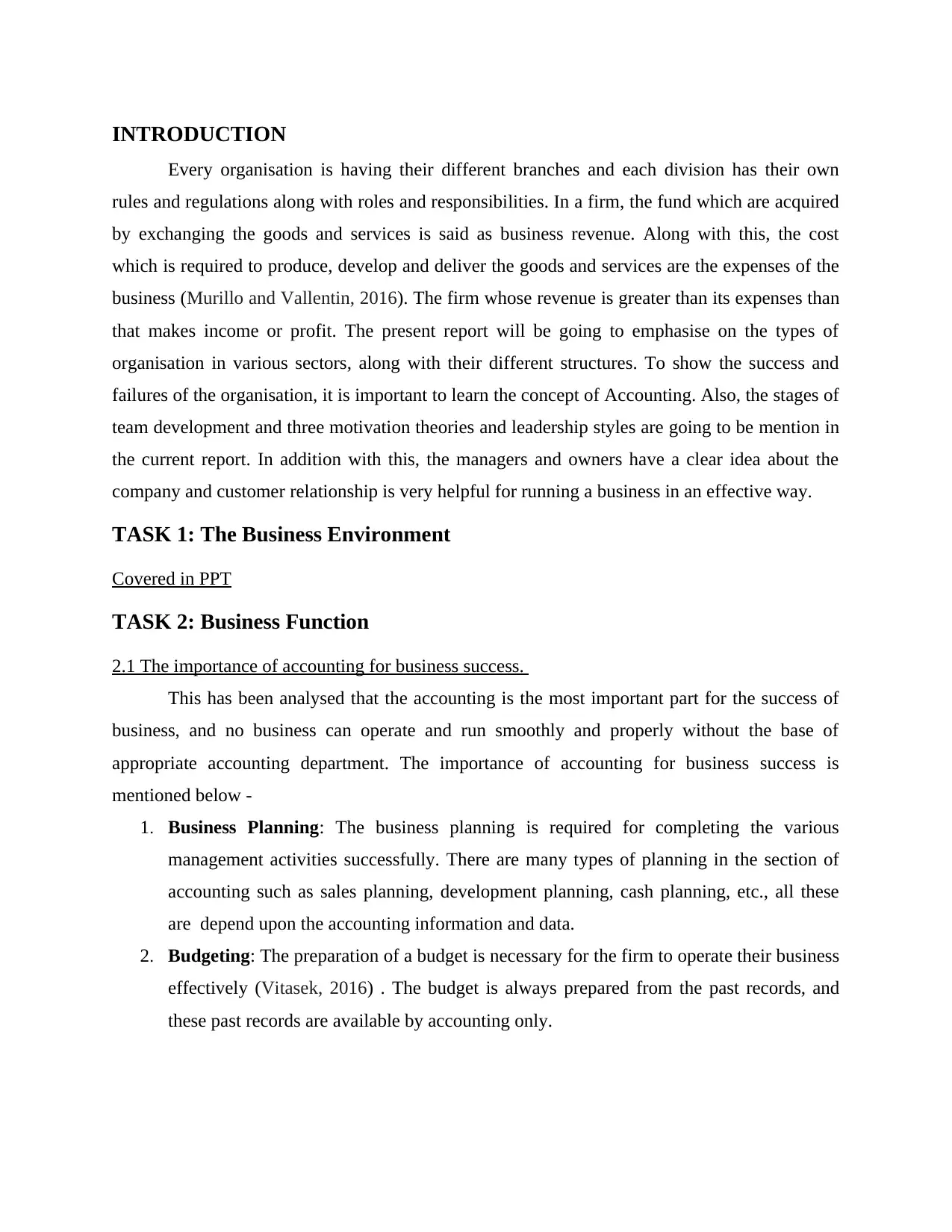
INTRODUCTION
Every organisation is having their different branches and each division has their own
rules and regulations along with roles and responsibilities. In a firm, the fund which are acquired
by exchanging the goods and services is said as business revenue. Along with this, the cost
which is required to produce, develop and deliver the goods and services are the expenses of the
business (Murillo and Vallentin, 2016). The firm whose revenue is greater than its expenses than
that makes income or profit. The present report will be going to emphasise on the types of
organisation in various sectors, along with their different structures. To show the success and
failures of the organisation, it is important to learn the concept of Accounting. Also, the stages of
team development and three motivation theories and leadership styles are going to be mention in
the current report. In addition with this, the managers and owners have a clear idea about the
company and customer relationship is very helpful for running a business in an effective way.
TASK 1: The Business Environment
Covered in PPT
TASK 2: Business Function
2.1 The importance of accounting for business success.
This has been analysed that the accounting is the most important part for the success of
business, and no business can operate and run smoothly and properly without the base of
appropriate accounting department. The importance of accounting for business success is
mentioned below -
1. Business Planning: The business planning is required for completing the various
management activities successfully. There are many types of planning in the section of
accounting such as sales planning, development planning, cash planning, etc., all these
are depend upon the accounting information and data.
2. Budgeting: The preparation of a budget is necessary for the firm to operate their business
effectively (Vitasek, 2016) . The budget is always prepared from the past records, and
these past records are available by accounting only.
Every organisation is having their different branches and each division has their own
rules and regulations along with roles and responsibilities. In a firm, the fund which are acquired
by exchanging the goods and services is said as business revenue. Along with this, the cost
which is required to produce, develop and deliver the goods and services are the expenses of the
business (Murillo and Vallentin, 2016). The firm whose revenue is greater than its expenses than
that makes income or profit. The present report will be going to emphasise on the types of
organisation in various sectors, along with their different structures. To show the success and
failures of the organisation, it is important to learn the concept of Accounting. Also, the stages of
team development and three motivation theories and leadership styles are going to be mention in
the current report. In addition with this, the managers and owners have a clear idea about the
company and customer relationship is very helpful for running a business in an effective way.
TASK 1: The Business Environment
Covered in PPT
TASK 2: Business Function
2.1 The importance of accounting for business success.
This has been analysed that the accounting is the most important part for the success of
business, and no business can operate and run smoothly and properly without the base of
appropriate accounting department. The importance of accounting for business success is
mentioned below -
1. Business Planning: The business planning is required for completing the various
management activities successfully. There are many types of planning in the section of
accounting such as sales planning, development planning, cash planning, etc., all these
are depend upon the accounting information and data.
2. Budgeting: The preparation of a budget is necessary for the firm to operate their business
effectively (Vitasek, 2016) . The budget is always prepared from the past records, and
these past records are available by accounting only.
Paraphrase This Document
Need a fresh take? Get an instant paraphrase of this document with our AI Paraphraser
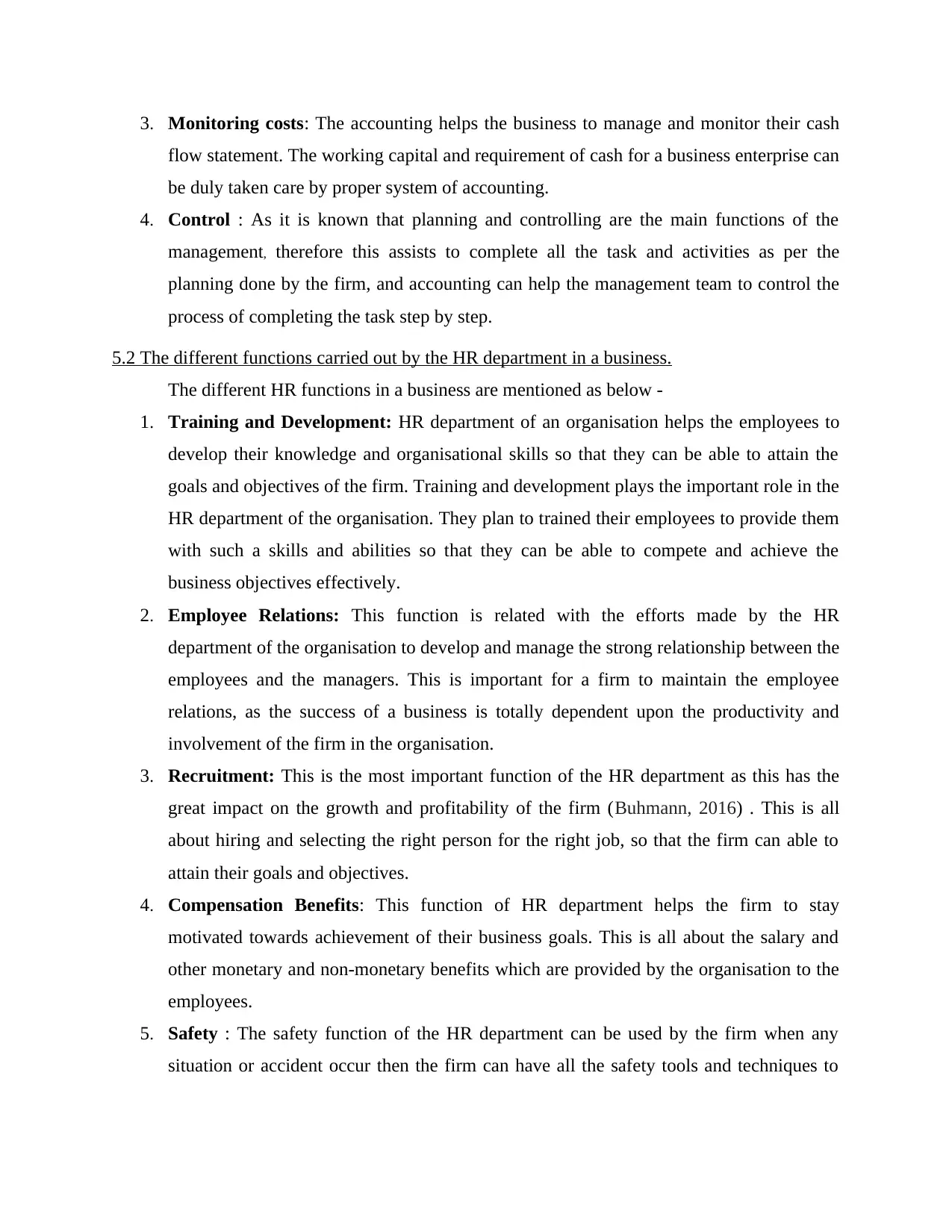
3. Monitoring costs: The accounting helps the business to manage and monitor their cash
flow statement. The working capital and requirement of cash for a business enterprise can
be duly taken care by proper system of accounting.
4. Control : As it is known that planning and controlling are the main functions of the
management, therefore this assists to complete all the task and activities as per the
planning done by the firm, and accounting can help the management team to control the
process of completing the task step by step.
5.2 The different functions carried out by the HR department in a business.
The different HR functions in a business are mentioned as below -
1. Training and Development: HR department of an organisation helps the employees to
develop their knowledge and organisational skills so that they can be able to attain the
goals and objectives of the firm. Training and development plays the important role in the
HR department of the organisation. They plan to trained their employees to provide them
with such a skills and abilities so that they can be able to compete and achieve the
business objectives effectively.
2. Employee Relations: This function is related with the efforts made by the HR
department of the organisation to develop and manage the strong relationship between the
employees and the managers. This is important for a firm to maintain the employee
relations, as the success of a business is totally dependent upon the productivity and
involvement of the firm in the organisation.
3. Recruitment: This is the most important function of the HR department as this has the
great impact on the growth and profitability of the firm (Buhmann, 2016) . This is all
about hiring and selecting the right person for the right job, so that the firm can able to
attain their goals and objectives.
4. Compensation Benefits: This function of HR department helps the firm to stay
motivated towards achievement of their business goals. This is all about the salary and
other monetary and non-monetary benefits which are provided by the organisation to the
employees.
5. Safety : The safety function of the HR department can be used by the firm when any
situation or accident occur then the firm can have all the safety tools and techniques to
flow statement. The working capital and requirement of cash for a business enterprise can
be duly taken care by proper system of accounting.
4. Control : As it is known that planning and controlling are the main functions of the
management, therefore this assists to complete all the task and activities as per the
planning done by the firm, and accounting can help the management team to control the
process of completing the task step by step.
5.2 The different functions carried out by the HR department in a business.
The different HR functions in a business are mentioned as below -
1. Training and Development: HR department of an organisation helps the employees to
develop their knowledge and organisational skills so that they can be able to attain the
goals and objectives of the firm. Training and development plays the important role in the
HR department of the organisation. They plan to trained their employees to provide them
with such a skills and abilities so that they can be able to compete and achieve the
business objectives effectively.
2. Employee Relations: This function is related with the efforts made by the HR
department of the organisation to develop and manage the strong relationship between the
employees and the managers. This is important for a firm to maintain the employee
relations, as the success of a business is totally dependent upon the productivity and
involvement of the firm in the organisation.
3. Recruitment: This is the most important function of the HR department as this has the
great impact on the growth and profitability of the firm (Buhmann, 2016) . This is all
about hiring and selecting the right person for the right job, so that the firm can able to
attain their goals and objectives.
4. Compensation Benefits: This function of HR department helps the firm to stay
motivated towards achievement of their business goals. This is all about the salary and
other monetary and non-monetary benefits which are provided by the organisation to the
employees.
5. Safety : The safety function of the HR department can be used by the firm when any
situation or accident occur then the firm can have all the safety tools and techniques to
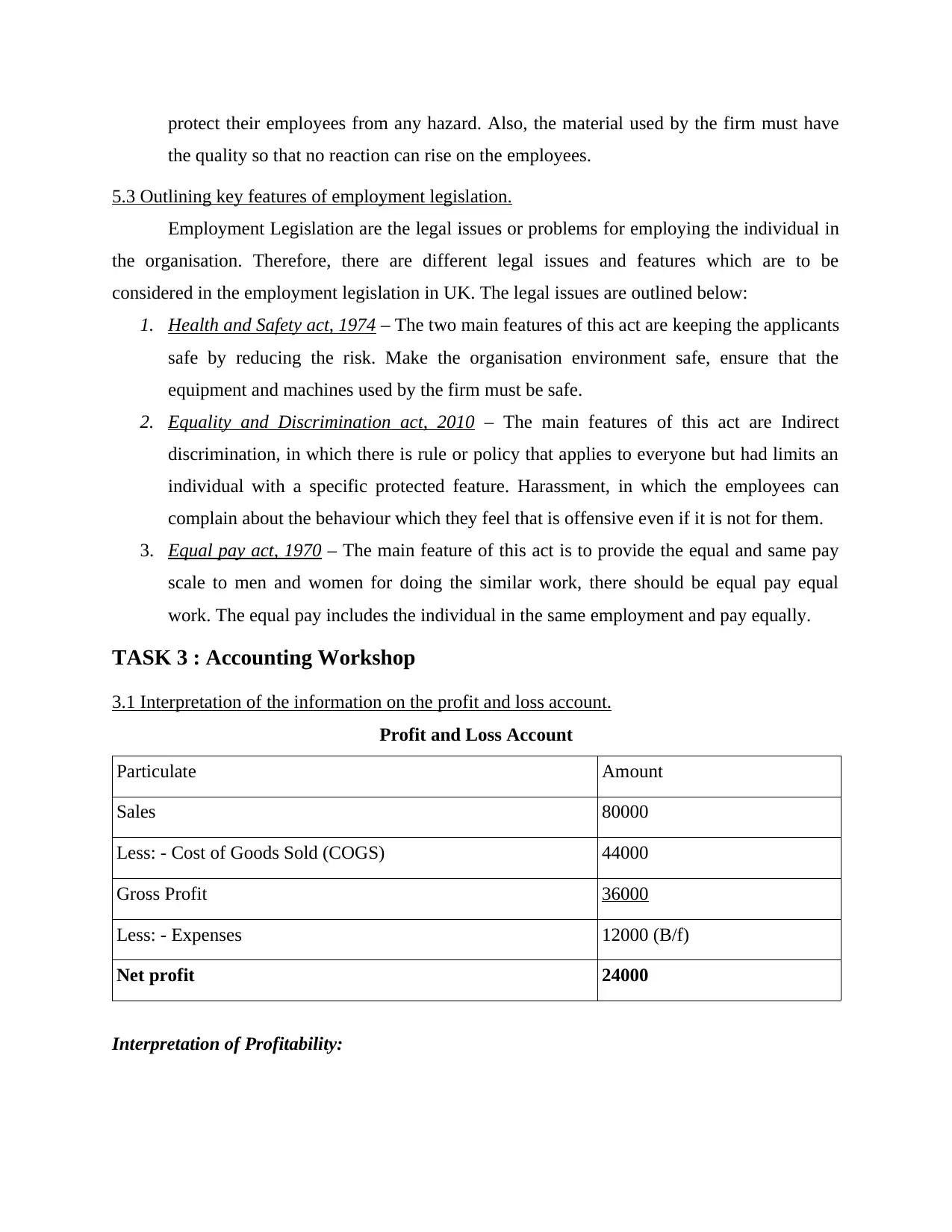
protect their employees from any hazard. Also, the material used by the firm must have
the quality so that no reaction can rise on the employees.
5.3 Outlining key features of employment legislation.
Employment Legislation are the legal issues or problems for employing the individual in
the organisation. Therefore, there are different legal issues and features which are to be
considered in the employment legislation in UK. The legal issues are outlined below:
1. Health and Safety act, 1974 – The two main features of this act are keeping the applicants
safe by reducing the risk. Make the organisation environment safe, ensure that the
equipment and machines used by the firm must be safe.
2. Equality and Discrimination act, 2010 – The main features of this act are Indirect
discrimination, in which there is rule or policy that applies to everyone but had limits an
individual with a specific protected feature. Harassment, in which the employees can
complain about the behaviour which they feel that is offensive even if it is not for them.
3. Equal pay act, 1970 – The main feature of this act is to provide the equal and same pay
scale to men and women for doing the similar work, there should be equal pay equal
work. The equal pay includes the individual in the same employment and pay equally.
TASK 3 : Accounting Workshop
3.1 Interpretation of the information on the profit and loss account.
Profit and Loss Account
Particulate Amount
Sales 80000
Less: - Cost of Goods Sold (COGS) 44000
Gross Profit 36000
Less: - Expenses 12000 (B/f)
Net profit 24000
Interpretation of Profitability:
the quality so that no reaction can rise on the employees.
5.3 Outlining key features of employment legislation.
Employment Legislation are the legal issues or problems for employing the individual in
the organisation. Therefore, there are different legal issues and features which are to be
considered in the employment legislation in UK. The legal issues are outlined below:
1. Health and Safety act, 1974 – The two main features of this act are keeping the applicants
safe by reducing the risk. Make the organisation environment safe, ensure that the
equipment and machines used by the firm must be safe.
2. Equality and Discrimination act, 2010 – The main features of this act are Indirect
discrimination, in which there is rule or policy that applies to everyone but had limits an
individual with a specific protected feature. Harassment, in which the employees can
complain about the behaviour which they feel that is offensive even if it is not for them.
3. Equal pay act, 1970 – The main feature of this act is to provide the equal and same pay
scale to men and women for doing the similar work, there should be equal pay equal
work. The equal pay includes the individual in the same employment and pay equally.
TASK 3 : Accounting Workshop
3.1 Interpretation of the information on the profit and loss account.
Profit and Loss Account
Particulate Amount
Sales 80000
Less: - Cost of Goods Sold (COGS) 44000
Gross Profit 36000
Less: - Expenses 12000 (B/f)
Net profit 24000
Interpretation of Profitability:
⊘ This is a preview!⊘
Do you want full access?
Subscribe today to unlock all pages.

Trusted by 1+ million students worldwide
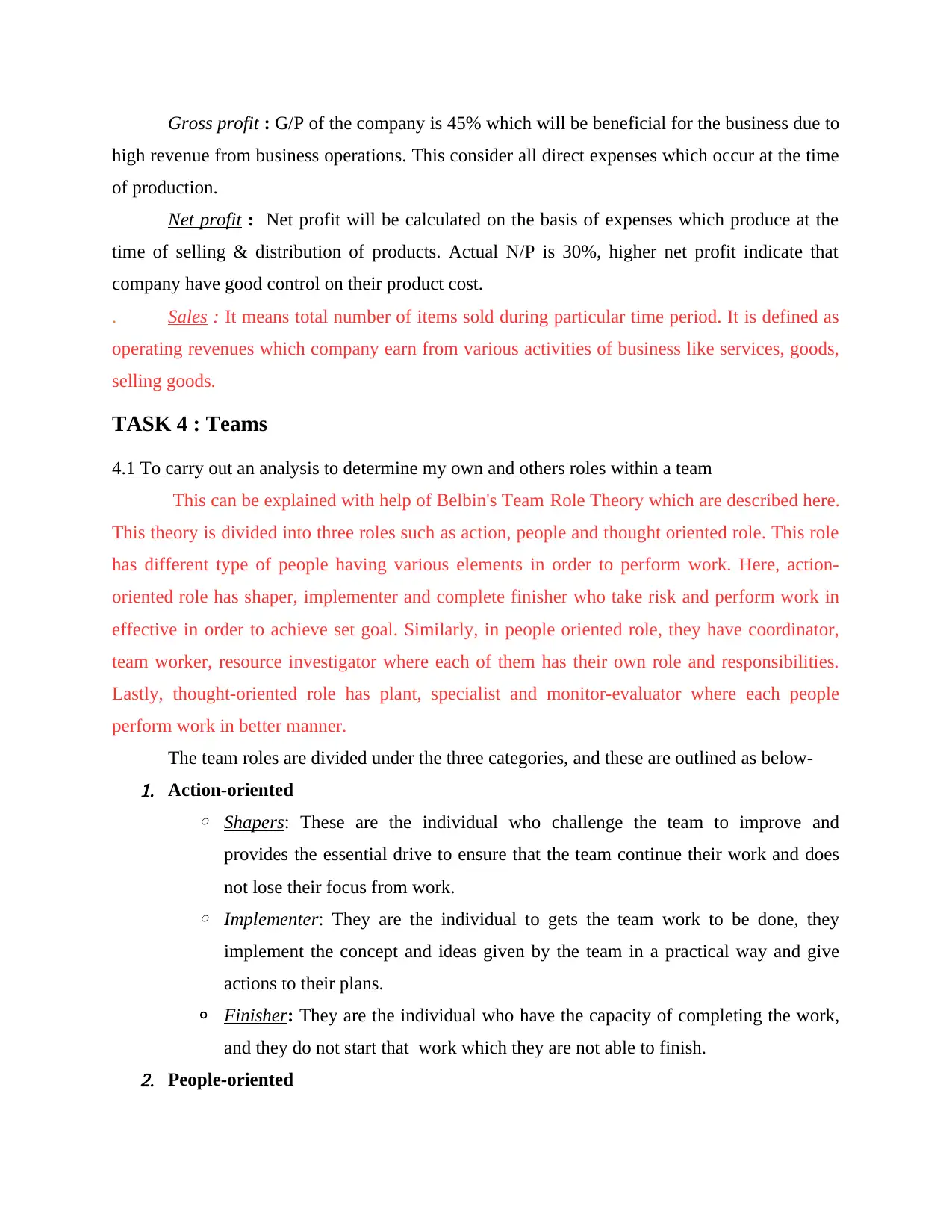
Gross profit : G/P of the company is 45% which will be beneficial for the business due to
high revenue from business operations. This consider all direct expenses which occur at the time
of production.
Net profit : Net profit will be calculated on the basis of expenses which produce at the
time of selling & distribution of products. Actual N/P is 30%, higher net profit indicate that
company have good control on their product cost.
. Sales : It means total number of items sold during particular time period. It is defined as
operating revenues which company earn from various activities of business like services, goods,
selling goods.
TASK 4 : Teams
4.1 To carry out an analysis to determine my own and others roles within a team
This can be explained with help of Belbin's Team Role Theory which are described here.
This theory is divided into three roles such as action, people and thought oriented role. This role
has different type of people having various elements in order to perform work. Here, action-
oriented role has shaper, implementer and complete finisher who take risk and perform work in
effective in order to achieve set goal. Similarly, in people oriented role, they have coordinator,
team worker, resource investigator where each of them has their own role and responsibilities.
Lastly, thought-oriented role has plant, specialist and monitor-evaluator where each people
perform work in better manner.
The team roles are divided under the three categories, and these are outlined as below-1. Action-oriented
◦ Shapers: These are the individual who challenge the team to improve and
provides the essential drive to ensure that the team continue their work and does
not lose their focus from work.
◦ Implementer: They are the individual to gets the team work to be done, they
implement the concept and ideas given by the team in a practical way and give
actions to their plans.
◦ Finisher: They are the individual who have the capacity of completing the work,
and they do not start that work which they are not able to finish.2. People-oriented
high revenue from business operations. This consider all direct expenses which occur at the time
of production.
Net profit : Net profit will be calculated on the basis of expenses which produce at the
time of selling & distribution of products. Actual N/P is 30%, higher net profit indicate that
company have good control on their product cost.
. Sales : It means total number of items sold during particular time period. It is defined as
operating revenues which company earn from various activities of business like services, goods,
selling goods.
TASK 4 : Teams
4.1 To carry out an analysis to determine my own and others roles within a team
This can be explained with help of Belbin's Team Role Theory which are described here.
This theory is divided into three roles such as action, people and thought oriented role. This role
has different type of people having various elements in order to perform work. Here, action-
oriented role has shaper, implementer and complete finisher who take risk and perform work in
effective in order to achieve set goal. Similarly, in people oriented role, they have coordinator,
team worker, resource investigator where each of them has their own role and responsibilities.
Lastly, thought-oriented role has plant, specialist and monitor-evaluator where each people
perform work in better manner.
The team roles are divided under the three categories, and these are outlined as below-1. Action-oriented
◦ Shapers: These are the individual who challenge the team to improve and
provides the essential drive to ensure that the team continue their work and does
not lose their focus from work.
◦ Implementer: They are the individual to gets the team work to be done, they
implement the concept and ideas given by the team in a practical way and give
actions to their plans.
◦ Finisher: They are the individual who have the capacity of completing the work,
and they do not start that work which they are not able to finish.2. People-oriented
Paraphrase This Document
Need a fresh take? Get an instant paraphrase of this document with our AI Paraphraser
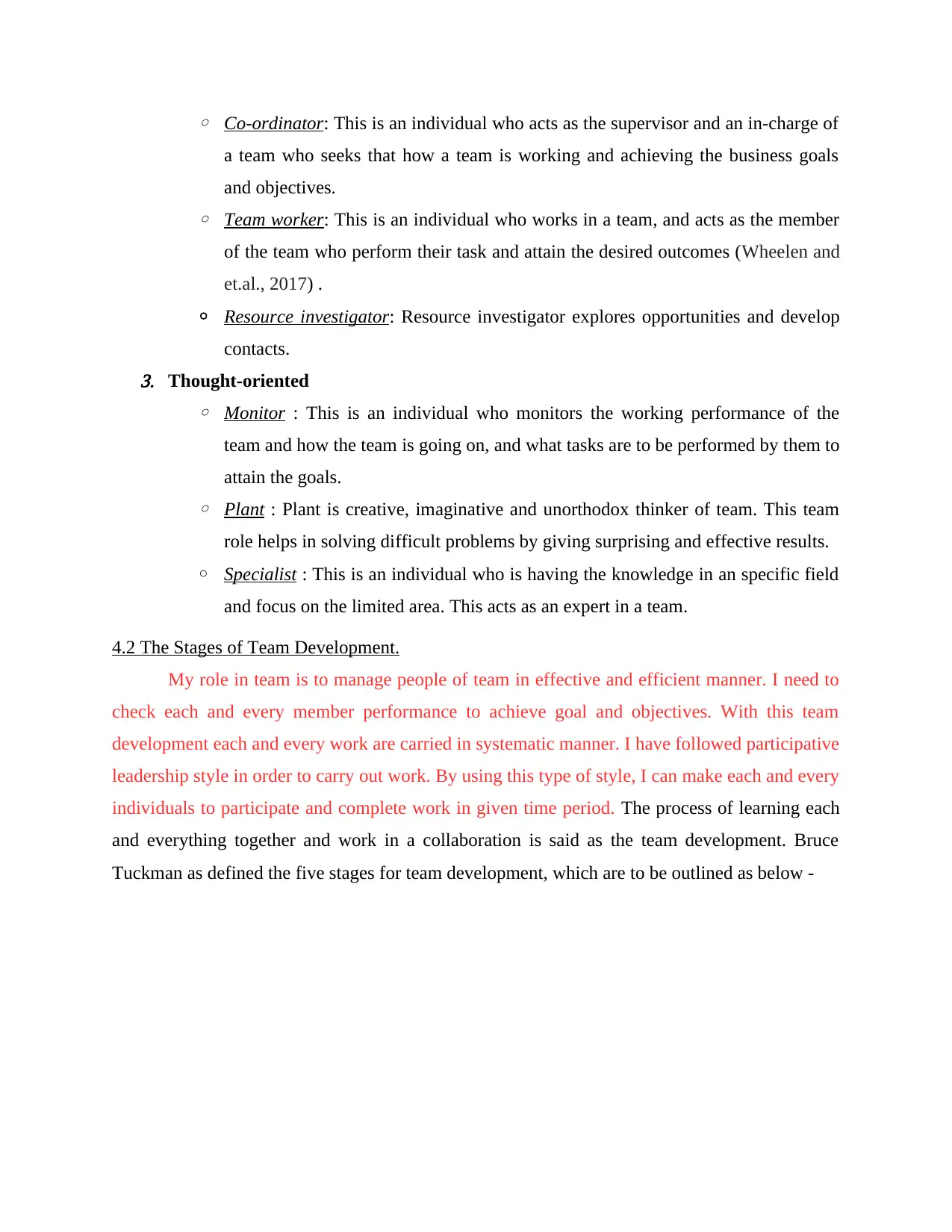
◦ Co-ordinator: This is an individual who acts as the supervisor and an in-charge of
a team who seeks that how a team is working and achieving the business goals
and objectives.
◦ Team worker: This is an individual who works in a team, and acts as the member
of the team who perform their task and attain the desired outcomes (Wheelen and
et.al., 2017) .
◦ Resource investigator: Resource investigator explores opportunities and develop
contacts.3. Thought-oriented
◦ Monitor : This is an individual who monitors the working performance of the
team and how the team is going on, and what tasks are to be performed by them to
attain the goals.
◦ Plant : Plant is creative, imaginative and unorthodox thinker of team. This team
role helps in solving difficult problems by giving surprising and effective results.
◦ Specialist : This is an individual who is having the knowledge in an specific field
and focus on the limited area. This acts as an expert in a team.
4.2 The Stages of Team Development.
My role in team is to manage people of team in effective and efficient manner. I need to
check each and every member performance to achieve goal and objectives. With this team
development each and every work are carried in systematic manner. I have followed participative
leadership style in order to carry out work. By using this type of style, I can make each and every
individuals to participate and complete work in given time period. The process of learning each
and everything together and work in a collaboration is said as the team development. Bruce
Tuckman as defined the five stages for team development, which are to be outlined as below -
a team who seeks that how a team is working and achieving the business goals
and objectives.
◦ Team worker: This is an individual who works in a team, and acts as the member
of the team who perform their task and attain the desired outcomes (Wheelen and
et.al., 2017) .
◦ Resource investigator: Resource investigator explores opportunities and develop
contacts.3. Thought-oriented
◦ Monitor : This is an individual who monitors the working performance of the
team and how the team is going on, and what tasks are to be performed by them to
attain the goals.
◦ Plant : Plant is creative, imaginative and unorthodox thinker of team. This team
role helps in solving difficult problems by giving surprising and effective results.
◦ Specialist : This is an individual who is having the knowledge in an specific field
and focus on the limited area. This acts as an expert in a team.
4.2 The Stages of Team Development.
My role in team is to manage people of team in effective and efficient manner. I need to
check each and every member performance to achieve goal and objectives. With this team
development each and every work are carried in systematic manner. I have followed participative
leadership style in order to carry out work. By using this type of style, I can make each and every
individuals to participate and complete work in given time period. The process of learning each
and everything together and work in a collaboration is said as the team development. Bruce
Tuckman as defined the five stages for team development, which are to be outlined as below -
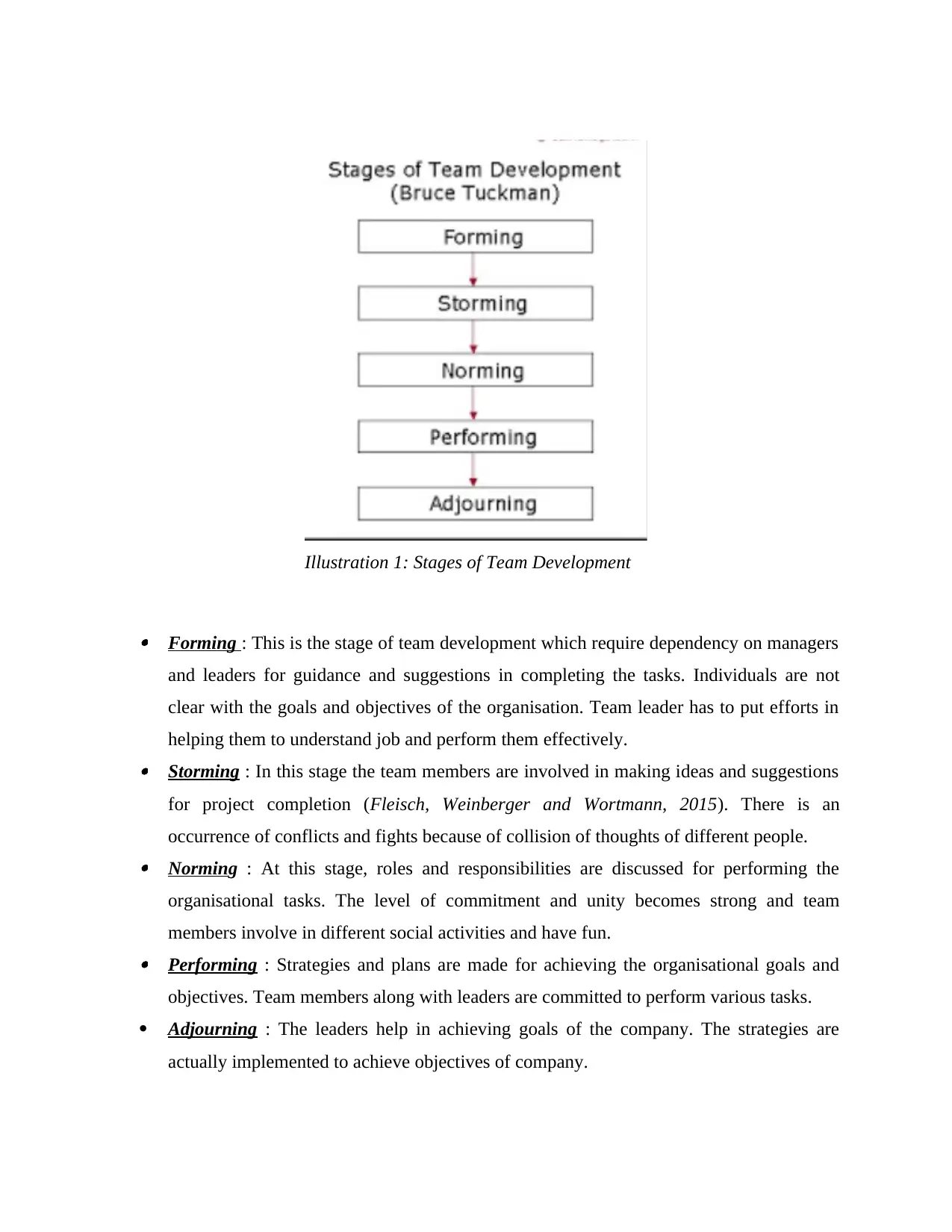
Forming : This is the stage of team development which require dependency on managers
and leaders for guidance and suggestions in completing the tasks. Individuals are not
clear with the goals and objectives of the organisation. Team leader has to put efforts in
helping them to understand job and perform them effectively. Storming : In this stage the team members are involved in making ideas and suggestions
for project completion (Fleisch, Weinberger and Wortmann, 2015). There is an
occurrence of conflicts and fights because of collision of thoughts of different people. Norming : At this stage, roles and responsibilities are discussed for performing the
organisational tasks. The level of commitment and unity becomes strong and team
members involve in different social activities and have fun. Performing : Strategies and plans are made for achieving the organisational goals and
objectives. Team members along with leaders are committed to perform various tasks.
Adjourning : The leaders help in achieving goals of the company. The strategies are
actually implemented to achieve objectives of company.
Illustration 1: Stages of Team Development
and leaders for guidance and suggestions in completing the tasks. Individuals are not
clear with the goals and objectives of the organisation. Team leader has to put efforts in
helping them to understand job and perform them effectively. Storming : In this stage the team members are involved in making ideas and suggestions
for project completion (Fleisch, Weinberger and Wortmann, 2015). There is an
occurrence of conflicts and fights because of collision of thoughts of different people. Norming : At this stage, roles and responsibilities are discussed for performing the
organisational tasks. The level of commitment and unity becomes strong and team
members involve in different social activities and have fun. Performing : Strategies and plans are made for achieving the organisational goals and
objectives. Team members along with leaders are committed to perform various tasks.
Adjourning : The leaders help in achieving goals of the company. The strategies are
actually implemented to achieve objectives of company.
Illustration 1: Stages of Team Development
⊘ This is a preview!⊘
Do you want full access?
Subscribe today to unlock all pages.

Trusted by 1+ million students worldwide
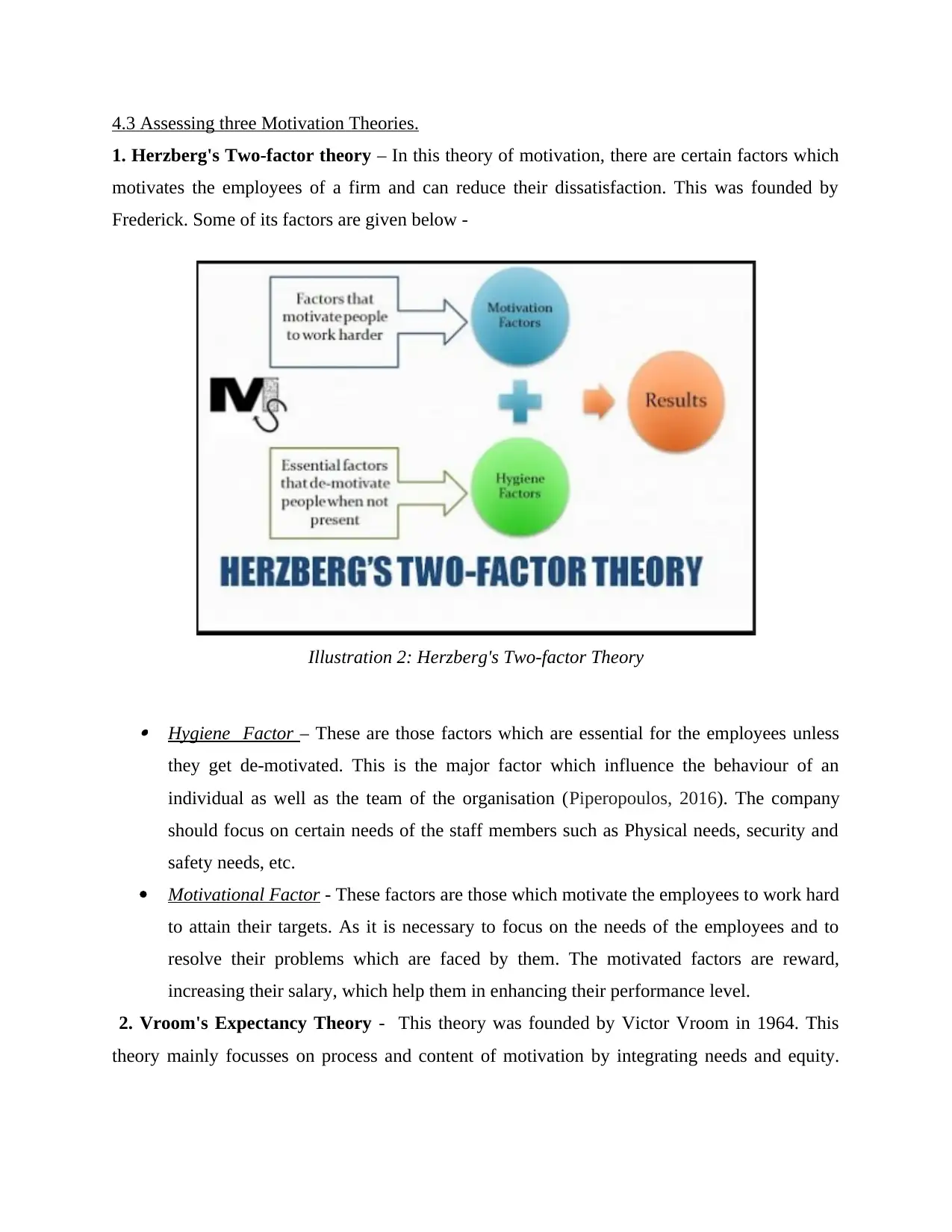
4.3 Assessing three Motivation Theories.
1. Herzberg's Two-factor theory – In this theory of motivation, there are certain factors which
motivates the employees of a firm and can reduce their dissatisfaction. This was founded by
Frederick. Some of its factors are given below -
Hygiene Factor – These are those factors which are essential for the employees unless
they get de-motivated. This is the major factor which influence the behaviour of an
individual as well as the team of the organisation (Piperopoulos, 2016). The company
should focus on certain needs of the staff members such as Physical needs, security and
safety needs, etc.
Motivational Factor - These factors are those which motivate the employees to work hard
to attain their targets. As it is necessary to focus on the needs of the employees and to
resolve their problems which are faced by them. The motivated factors are reward,
increasing their salary, which help them in enhancing their performance level.
2. Vroom's Expectancy Theory - This theory was founded by Victor Vroom in 1964. This
theory mainly focusses on process and content of motivation by integrating needs and equity.
Illustration 2: Herzberg's Two-factor Theory
1. Herzberg's Two-factor theory – In this theory of motivation, there are certain factors which
motivates the employees of a firm and can reduce their dissatisfaction. This was founded by
Frederick. Some of its factors are given below -
Hygiene Factor – These are those factors which are essential for the employees unless
they get de-motivated. This is the major factor which influence the behaviour of an
individual as well as the team of the organisation (Piperopoulos, 2016). The company
should focus on certain needs of the staff members such as Physical needs, security and
safety needs, etc.
Motivational Factor - These factors are those which motivate the employees to work hard
to attain their targets. As it is necessary to focus on the needs of the employees and to
resolve their problems which are faced by them. The motivated factors are reward,
increasing their salary, which help them in enhancing their performance level.
2. Vroom's Expectancy Theory - This theory was founded by Victor Vroom in 1964. This
theory mainly focusses on process and content of motivation by integrating needs and equity.
Illustration 2: Herzberg's Two-factor Theory
Paraphrase This Document
Need a fresh take? Get an instant paraphrase of this document with our AI Paraphraser
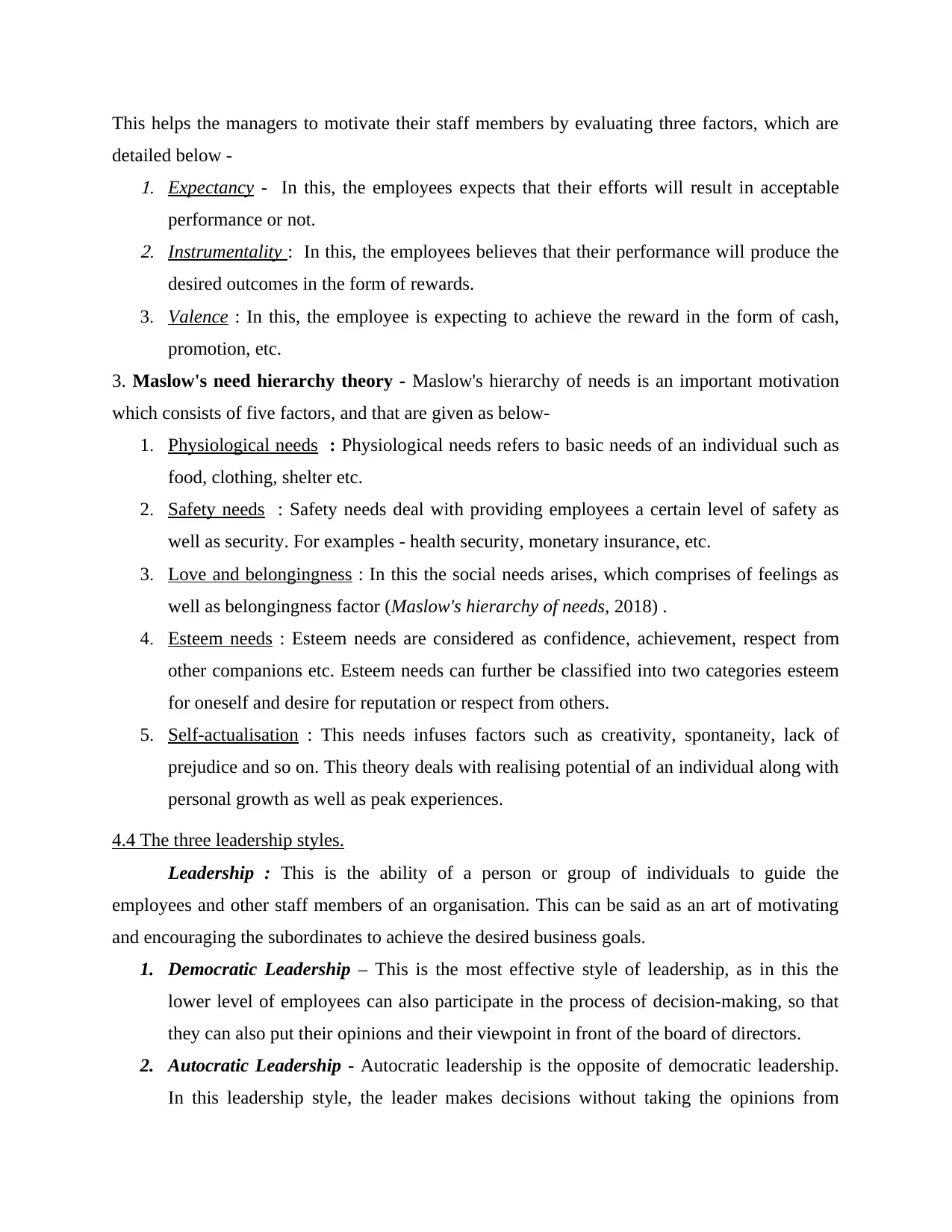
This helps the managers to motivate their staff members by evaluating three factors, which are
detailed below -1. Expectancy - In this, the employees expects that their efforts will result in acceptable
performance or not.2. Instrumentality : In this, the employees believes that their performance will produce the
desired outcomes in the form of rewards.
3. Valence : In this, the employee is expecting to achieve the reward in the form of cash,
promotion, etc.
3. Maslow's need hierarchy theory - Maslow's hierarchy of needs is an important motivation
which consists of five factors, and that are given as below-
1. Physiological needs : Physiological needs refers to basic needs of an individual such as
food, clothing, shelter etc.
2. Safety needs : Safety needs deal with providing employees a certain level of safety as
well as security. For examples - health security, monetary insurance, etc.
3. Love and belongingness : In this the social needs arises, which comprises of feelings as
well as belongingness factor (Maslow's hierarchy of needs, 2018) .
4. Esteem needs : Esteem needs are considered as confidence, achievement, respect from
other companions etc. Esteem needs can further be classified into two categories esteem
for oneself and desire for reputation or respect from others.
5. Self-actualisation : This needs infuses factors such as creativity, spontaneity, lack of
prejudice and so on. This theory deals with realising potential of an individual along with
personal growth as well as peak experiences.
4.4 The three leadership styles.
Leadership : This is the ability of a person or group of individuals to guide the
employees and other staff members of an organisation. This can be said as an art of motivating
and encouraging the subordinates to achieve the desired business goals.
1. Democratic Leadership – This is the most effective style of leadership, as in this the
lower level of employees can also participate in the process of decision-making, so that
they can also put their opinions and their viewpoint in front of the board of directors.
2. Autocratic Leadership - Autocratic leadership is the opposite of democratic leadership.
In this leadership style, the leader makes decisions without taking the opinions from
detailed below -1. Expectancy - In this, the employees expects that their efforts will result in acceptable
performance or not.2. Instrumentality : In this, the employees believes that their performance will produce the
desired outcomes in the form of rewards.
3. Valence : In this, the employee is expecting to achieve the reward in the form of cash,
promotion, etc.
3. Maslow's need hierarchy theory - Maslow's hierarchy of needs is an important motivation
which consists of five factors, and that are given as below-
1. Physiological needs : Physiological needs refers to basic needs of an individual such as
food, clothing, shelter etc.
2. Safety needs : Safety needs deal with providing employees a certain level of safety as
well as security. For examples - health security, monetary insurance, etc.
3. Love and belongingness : In this the social needs arises, which comprises of feelings as
well as belongingness factor (Maslow's hierarchy of needs, 2018) .
4. Esteem needs : Esteem needs are considered as confidence, achievement, respect from
other companions etc. Esteem needs can further be classified into two categories esteem
for oneself and desire for reputation or respect from others.
5. Self-actualisation : This needs infuses factors such as creativity, spontaneity, lack of
prejudice and so on. This theory deals with realising potential of an individual along with
personal growth as well as peak experiences.
4.4 The three leadership styles.
Leadership : This is the ability of a person or group of individuals to guide the
employees and other staff members of an organisation. This can be said as an art of motivating
and encouraging the subordinates to achieve the desired business goals.
1. Democratic Leadership – This is the most effective style of leadership, as in this the
lower level of employees can also participate in the process of decision-making, so that
they can also put their opinions and their viewpoint in front of the board of directors.
2. Autocratic Leadership - Autocratic leadership is the opposite of democratic leadership.
In this leadership style, the leader makes decisions without taking the opinions from
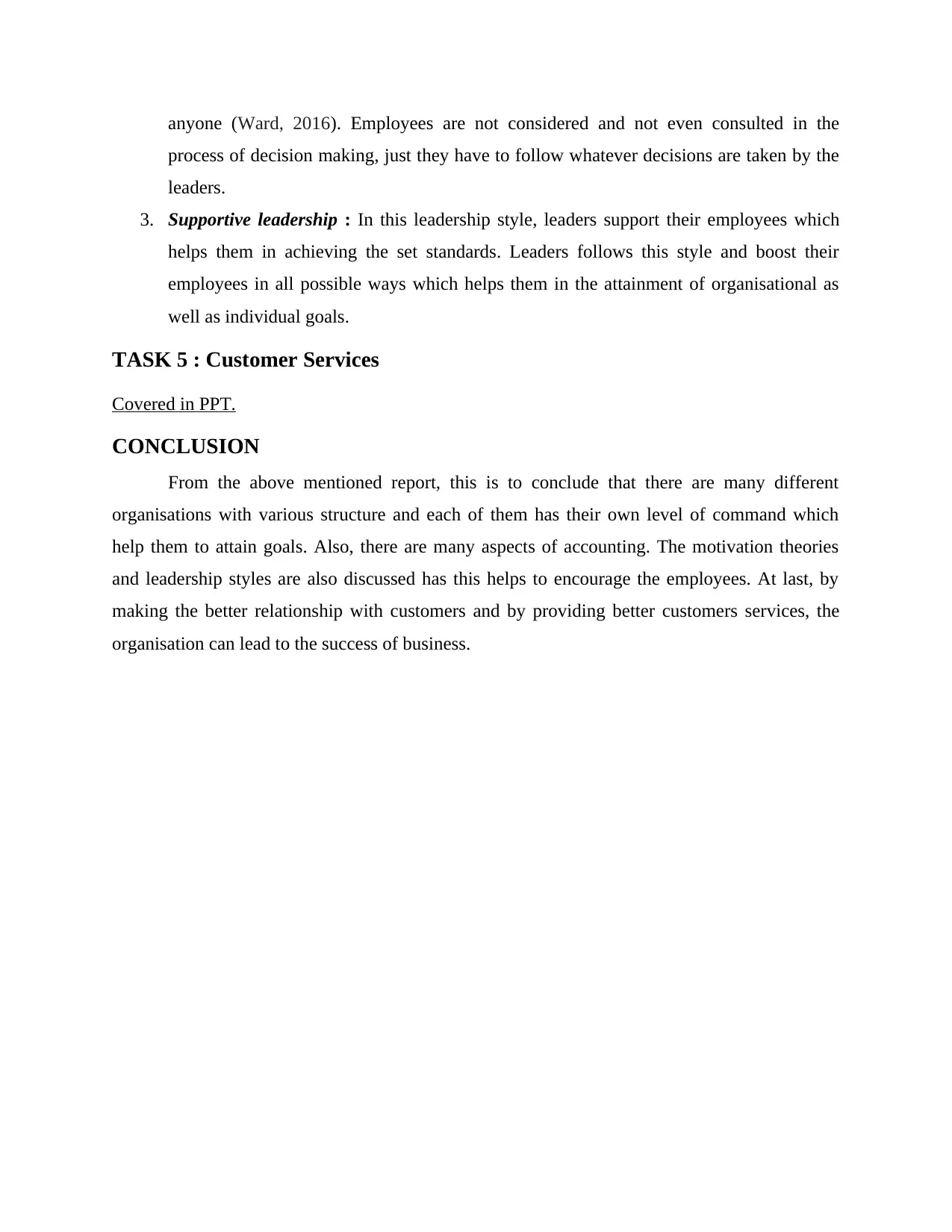
anyone (Ward, 2016). Employees are not considered and not even consulted in the
process of decision making, just they have to follow whatever decisions are taken by the
leaders.
3. Supportive leadership : In this leadership style, leaders support their employees which
helps them in achieving the set standards. Leaders follows this style and boost their
employees in all possible ways which helps them in the attainment of organisational as
well as individual goals.
TASK 5 : Customer Services
Covered in PPT.
CONCLUSION
From the above mentioned report, this is to conclude that there are many different
organisations with various structure and each of them has their own level of command which
help them to attain goals. Also, there are many aspects of accounting. The motivation theories
and leadership styles are also discussed has this helps to encourage the employees. At last, by
making the better relationship with customers and by providing better customers services, the
organisation can lead to the success of business.
process of decision making, just they have to follow whatever decisions are taken by the
leaders.
3. Supportive leadership : In this leadership style, leaders support their employees which
helps them in achieving the set standards. Leaders follows this style and boost their
employees in all possible ways which helps them in the attainment of organisational as
well as individual goals.
TASK 5 : Customer Services
Covered in PPT.
CONCLUSION
From the above mentioned report, this is to conclude that there are many different
organisations with various structure and each of them has their own level of command which
help them to attain goals. Also, there are many aspects of accounting. The motivation theories
and leadership styles are also discussed has this helps to encourage the employees. At last, by
making the better relationship with customers and by providing better customers services, the
organisation can lead to the success of business.
⊘ This is a preview!⊘
Do you want full access?
Subscribe today to unlock all pages.

Trusted by 1+ million students worldwide
1 out of 13
Related Documents
Your All-in-One AI-Powered Toolkit for Academic Success.
+13062052269
info@desklib.com
Available 24*7 on WhatsApp / Email
![[object Object]](/_next/static/media/star-bottom.7253800d.svg)
Unlock your academic potential
Copyright © 2020–2025 A2Z Services. All Rights Reserved. Developed and managed by ZUCOL.





